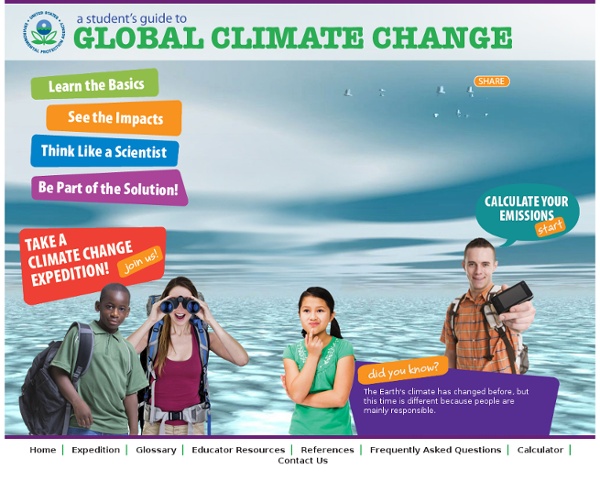



Global warming Global mean land-ocean temperature change from 1880 to 2014, relative to the 1951–1980 mean. The black line is the annual mean and the red line is the 5-year running mean. The green bars show uncertainty estimates. Source: NASA GISS. The map shows the 10-year average (2000–2009) global mean temperature anomaly relative to the 1951–1980 mean. Fossil fuel related carbon dioxide (CO2) emissions compared to five of the IPCC's "SRES" emissions scenarios. Global warming and climate change can both refer to the observed century-scale rise in the average temperature of the Earth's climate system and its related effects, although climate change can also refer to any historic change in climate. Scientific understanding of the cause of global warming has been increasing. Climate model projections were summarized in the 2013 Fifth Assessment Report (AR5) by the IPCC. Observed temperature changes Temperature changes vary over the globe. Initial causes of temperature changes (external forcings)
CLEAN database Y3-5 Documenting Glacial Change A collection of repeat photography of glaciers from the National Snow and Ice Data Center (NSIDC). The photos are taken years apart at or near the same location, illustrating how dramatically glacier ... Samoa Under Threat This video adapted from Bullfrog Films examines the effects of global warming on the Pacific island of Samoa with testimonials from an expert in both western science knowledge and traditional ... Water, Water Everywhere This is a short NASA video on the water cycle. Take Aim At Climate Change This music video features a rap song about some of the causes and effects of climate change with the goal of increasing awareness of climate change and how it will impact nature and humans. Deforestation in the Amazon This NASA animation on land cover change zooms into Rondonia, Brazil. Milankovitch Cycles How Does Melting Ice Affect Sea Level? Inland Fish and Warming Waters Global Ice Viewer The Energy Game: Finding Energy Resources
Stop climate change Deeply complex, the climate system drives wind, water, and warmth around our beautiful blue planet, nurturing all life. But now our climate is changing fast. The cause is an old, broken energy system that pollutes our air and water, drives inequality and destroys priceless landscapes. Climate affects all life on Earth Our climate is the engine for life support systems that sustain and nurture us all. The climate is changing fast Sea levels are rising, glaciers are melting, and coral reefs are bleaching. Climate change threatens to unravel Earth's complex web of life, and puts livelihoods, coastal cities and food production at risk. The cause of climate change is certain A dirty energy system, fuelled by coal, oil, gas and nuclear power, has failed us. The polluters profit, while the rest of us pay the price. We must break our remaining ties to this old, lumbering energy system of the past. 100% renewable energy is the key We've already begun to change. Greenpeace fights the polluters
Learn about Photosynthesis | Science With Me! Very few plants can actually trap their own food and none can go grocery shopping so plants need to make their food by themselves if they want to eat! Plants are fortunate as they are the only living organisms that can make their own food. How do they do this? They make their food by combining carbon dioxide gas that is found in air with water and nutrients that they absorb from the soil. In order to do this though they need energy – which they get from sunlight. We can write photosynthesis like this: Carbon Dioxide(gas) + Water => sunlight => Glucose + Oxygen(gas) 6 CO2 + 12 H2O —-sunlight——> C6 H12 O6 + 6 H2O + 6 O2 In the process of photosynthesis plants change solar energy into chemical energy. What has the sun got to do with photosynthesis? The sun is a very powerful source of energy. How do plants capture the sun’s energy? Plants can do this because of leaf structures called chloroplasts that contain a special substance called chlorophyll. Why are most leaves broad and flat?
Cool Antarctica, pictures of Antarctica, information and travel guide Weather Centre - Climate Change - Evidence Global Climate Change: Research Explorer- The Exploratorium The earth’s climate has warmed and cooled for millions of years, since long before we appeared on the scene. There’s no doubt that the climate is growing warmer currently; indications of that change are all around us. Though climate change isn’t new, the study of how human activity affects the earth’s climate is. At this Web site, you can explore scientific data relating to the atmosphere, the oceans, the areas covered by ice and snow, and the living organisms in all these domains.